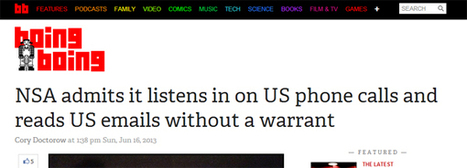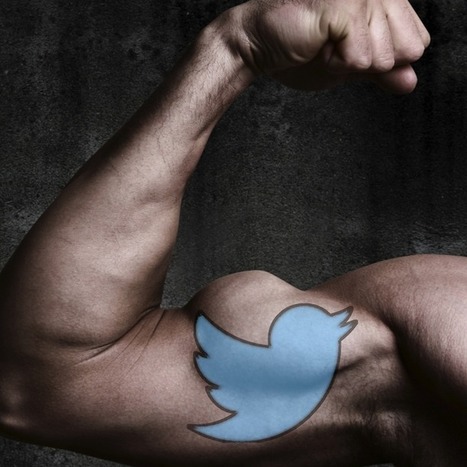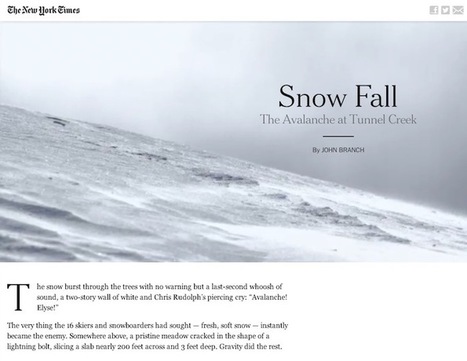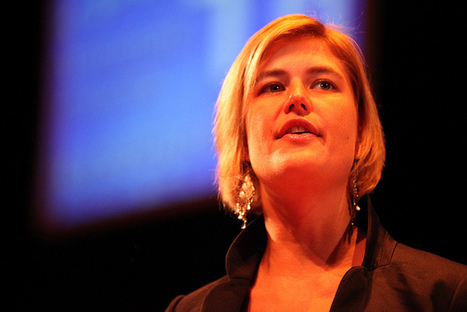 Your new post is loading...
 Your new post is loading...
In recent days media has been consumed by one Edward Snowdenwho revealed a Skynet-type infrastructure called Prism that the government is running. At the same time it appears as if traditional cable TV business is gearing up for a Game of Thrones-style war with many “kingdoms” that include Intel, Aereo, Netflix, Hulu, Amazon, YouTube and more. Are the cable TV walls about to crumble?
The war to bundle TV in a non-traditional way continues and big players are stepping up...
...The company is finding that the most popular content for tablets depends on the title. Golf Digest sees great success with video. Generally speaking, long-form editorial content like actual stories, video and slideshows do well across the board because the tablet is a lean-back device, where consumers aren’t looking for short snippets of content like they are on a mobile phone, for example.
“If you look at the time of day with highest tablet usage it’s usually during prime time or on the weekends,” Reynolds said. “That’s why we are developing tablet-specific content to fit that different mindset. We’re not worried about tablet usage cannibalizing Web usage because Web, tablet and mobile, are all part of a complementary ecosystem.”
Reynold’s said that the biggest opportunity for Conde Nast in the tablet space is the amount of data is has on subscribers. It gives the publisher a look at the preferences that people have for content and advertising on specific devices and Conde Nast can optimize based on that.
... Scribble’s traction is international; its ScribbleLive real-time content creation and distribution platform is available in 14 languages and used by the biggest media brands, including the Associated Press, Reuters, CNN and ESPN to name a few. I spoke with Scribble CEO and co-founder Michael De Monte about the raise, and his vision for the company.
He pointed out that Scribble recently launched ScribbleMarket, a way for brands to easily syndicate their live content, and to find said content from other sources for use on their own site. Licensing can be free or paid, and this lets news agencies quickly leverage their reporting resources for additional income streams, by providing not just static articles for syndication as has been the case, but full-featured, interactive real-time content that’s being dynamically updated from a single backend.
quiet“The marketplace for us is the exciting component of what we’re building,” De Monte said. “This opportunity to share content in real time, becoming like the iTunes of real-time content has a lot of potential to change the face of media.”...
It happened with the Washington Post‘s initial PRISM story, it happened with Glenn Greenwald’s story in which he wrote that the NSA has “direct access” to servers owned by the various tech giants and, over the weekend, it happened in spectacular fashion with a bombshell article posted on CNET by chief political correspondent Declan McCullagh.The headline that dispersed through social media and political blogs like the swine flu: “NSA admits listening to U.S. phone calls without warrants.”When I spotted the headline, tweeted by a reporter who I otherwise respect, my first reaction was, “Wow. Okay.”
But as I read the article, the headline became less and less accurate — a trend we’ve witnessed several times recently. In fact, McCullagh’s reporting almost entirely disintegrated under just cursory scrutiny… but not before it went viral.McCullagh reported that during a House Judiciary Committee hearing featuring FBI Director Mueller, Rep. Jerrold Nadler (D-NY) revealed that the NSA, during a previous secret briefing, admitted that thousands of NSA analysts could to listen to phone calls without warrants. That was the thrust of McCullagh’s story. But the quotes were awkwardly truncated, the tic-toc of the story was unclear and there were highly speculative paragraphs that jumped to conclusions not supported by the reporting....
...The starting point to understanding the how mainstream media fails to accurately report the news is the consolidation of media ownership in the United States. In 1983 50 corporations controlled the vast majority of all news media in the U.S. In 2002 that number had decreased to 10 companies (McChesney & Nichols, 2002). By 2004 that number had decreased to only five companies. As Nichols and McChesney state, All in all, these [few] firms control the overwhelming percentage of movies, TV shows, cable systems, cable channels, TV stations, radio stations, books, magazines, newspapers, billboards, music and TV networks that constitute the media culture that occupies one half of the average American’s life.
It is an extraordinary degree of economic and social power located in very few hands (Nichols & McChesney, It's the Media Stupid, 2000, p. 28).Five companies control the bulk of information disseminated to the American public via mainstream media. How can one have a diverse discussion of ideas if a handful of people or, in the case of the media, a handful of corporations controls the information that the public receives via mainstream media? The answer is that one cannot. Corporations have one interest in mind: Profit above all else. Financial gain is their only reason for existence. Informing the public is not the corporate media’s principal function, making money is....
Not long ago, the media looked at the web as if it was an awkward, unwanted stepchild. Today, the reverse is arguably true, with debate growing over whether social networks such as Twitter will overtake beacons of journalism like The New York Times. At last month's Milken Institute Global Conference, PayPal co-founder Peter Thiel said he thinks Twitter will outlast The Times. His reasoning: Its business strategy is more solid than that of the storied newspaper. The debate got journalists talking on forums such as Muck Rack, with many people disagreeing. Some said it isn't a mutually exclusive relationship, or that one's success is predicated on the other's failure....
The academic and business publication has quietly grown a digital presence.... Over the last several years, the Harvard Business Review has quietly grown its digital presence, and it points to social as the main reason. HBR is a cross between a magazine and an academic journal. But with the exponential growth in digital, the outlet is trying to be more egalitarian without watering down its heavily researched and often didactic business-management content. The publication, which costs $100 per year or $17 a month, believes social media’s role as a democratization tool can make its content more accessible to a wider audience. “Social has been a key channel for us to increase the impact of these ideas,” said Eric Hellweg, HBR’s digital strategy director. “That’s the heart of what we do. But to unearth these ideas and tell them in the social realm, it becomes an effective way to spread these ideas around the world. It’s a great way to get reach and influence.”...
I am often asked what it takes to be a great reporter in the digital era. The essential mission, I say, remains the same: to observe, collect and interpret information. Don’t be a generalist; pick a subject, dig deep into it, bring “passion” to the job. That word evokes the obligatory question about objectivity. My response: journalism has always entailed biases, conscious or not. Next, a great reporter engages one-on-one with news consumers, joins social news streams, learns to be a marketer and plays with the technology. I end with this: understand the business models behind the profession — and start to think like an entrepreneur. FORBES has 1,000 writers learning and practicing all of that. Here are four who are leading the way...
When it comes to the traditional media business, there is often a pervasive nostalgia for “the good old days,” when a handful of newspapers and TV networks ruled over the media landscape and profitability was so taken for granted that huge family dynasties with names like Sulzberger and Bancroft were built on that foundation. Many media executives no doubt dream about magically returning to such a time. But what if those days were just an illusion — a kind of accident of history? What would that mean for the future of media? This idea has come up before, but I was reminded of it when I read a Nieman Journalism Lab post about some research being done by Lee Humphreys, looking at the way that communication — and particularly personal communication, through letters and diaries and other pre-digital tools of expression. Although this doesn’t seem to have much to do with how we use ultra-modern services like Twitter or Facebook, there is a lot more to it than you might think....
In the U.S. and abroad, a new set of B2B media products are showing there's room for growth in niches — and that there's new power in incumbency.... ...Much of Atlantic Media’s sales, marketing, analytics and financial functions can be leveraged to support the new product, minimizing what would be similar expense for a one-off start-up. Also like Quartz, it is going free, looking to marketers to make it profitable. It isn’t just an ad play. Rather, it looks to an emerging model of higher-end sponsorship and content marketing — with the important adjunct of events marketing — to propel it forward. Its offer to marketers will follow the playbook of what Atlantic Media’s half-dozen other publications (The Atlantic, The Atlantic Wire, The Atlantic Cities, Quartz, National Journal, Government Executive) now offers. It’s on-site sponsorship/share-of-voice placement, content marketing, and marketing services aid and placements and sponsorship of physical events. That events business rides right alongside inclusion on its websites, providing marketers with a brand association that fluidly moves from online to off and back. It’s a strategy now well-employed in D.C. — also exploited by Politico and The Washington Post — and among events leaders like The Texas Tribune. Atlantic Media has turned events into a potent, higher-margin revenue source, now accounting for around 16 percent of revenues....
A chart making the rounds this week showed that annual newspaper advertising revenue has fallen from a high of more than $60 billion around 2000 to about $20 billion in 2011. Stunning, yes. Put that chart against ASNE’s annual survey of newspapers’ newsroom employment and you see see something else: Newspapers employ about the same number of journalists as in the late 1970s, and they’re paying for them with roughly the same amount of advertising revenue as in the 1950s. How’s that for confirmation that journalists are doing more with less? The chart posted by University of Michigan professor Mark J. Perry showed that print advertising revenue is at a 60-year-low, just over $20 billion....
Twitter is a frenemy," said Jeff Zucker, CNN's new president, as reported by MediaShift. Jeff Zucker was describing the cable news network's relationship with social media and added, “the network uses, relies on -- and is scared by -- social media.” Twitter had a marquee moment last week, particularly late Friday afternoon and evening, that should scare most television news outlets in the business of reporting breaking news. That’s when Boston Marathon bombing suspect Dzhokhar Tsarnaev was cornered by police, trapped and almost bleeding to death inside a covered boat in a backyard in Watertown, Mass....
“It’s become a verb in our newsroom,” a New York Times graphics producer tells me. “People are now saying, ‘can we snowfall this story?’” Snow Fall: The Avalanche at Tunnel Creek has become a watershed in multimedia journalism. The story by John Branch recently won a Pulitzer prize in feature writing, and as noted by the Pulitzer website it was “a project enhanced by its deft integration of multimedia elements.” As a journalism educator, I’m constantly collecting links to examples of stories that attempt innovate and redefine the narrative form online. For years, story structures online have mostly been a repurposing of legacy formats — TV, radio and print. While we are starting to see the journalism industry leverage digital media in very powerful ways, more often it’s a complementary component to a more traditional story structure. For example, you might see an interactive graphic or map or audio slideshow off to the side of a text story. Then came Snow Fall....
|
Traditional journalists probably won't like a lot of how Upworthy's become one of the fastest growing aggregators on the web. But it's hard to question the effectiveness of its methods.
Back in November, the Lab’s own Adrienne LaFrance wrote a number of words about Upworthy, a social packaging and not-quite-news site that has become remarkably successful at making “meaningful content” go viral. She delved into their obsession with testing headlines, their commitment to things that matter, their aggressive pushes across social media, and their commitment to finding stories with emotional resonance.
Things have continued to go well for Upworthy — they’re up to 10 million monthly uniques from 7.5. At the Personal Democracy Forum in New York, editorial director Sara Critchfield shared what she sees as Upworthy’s secret sauce for shareability, namely, seeking out content that generates a significant emotional response from both the reader and the writer....
The best thinking about journalism’s future benefits from its being in touch with technology’s potential. But it can get in its own way when it simplifies and repudiates the intelligence of journalism’s past.
That is happening, to a degree, in a discussion gaining momentum lately that journalism should now largely move beyond fact gathering and toward synthesis and interpretation.
The NSA story is just the latest case that shows the importance, and the elusiveness, of simply knowing what has really happened.
In a Nieman Journalism Lab post, Jonathan Stray made the case recently for moving beyond facts, or what might be called The Displacement Theory of Journalism. “The Internet has solved the basic distribution of event-based facts in a variety of ways; no one needs a news organization to know what the White House is saying when all press briefings are posted on YouTube. What we do need is someone to tell us what it means.”...
On June 6, 2011, Scott Pelley took over as anchor of the CBS Evening News, his tenure following Katie Couric’s five-year run. The once-dominant newscast had fallen to third place behind NBC and ABCduring the end of Dan Rather’s reign, and Couric’s stint saw the broadcast fall to record ratings lows. While still No. 3 among the Big Three, the CBS Evening News With Scott Pelley has seen significant growth since the Texan took over after a long run at sibling 60 Minutes.
In the past year, the 6:30 PM broadcast has added 490,000 viewers, the largest annual increase for the network’s evening news in 15 years and the best among the broadcast news rivals since 2002. Overall, the CBS Evening News is up 12% in viewers since Pelley’s debut. Just before his second anniversary in the anchor chair, Deadline spoke with Pelley about the relevance of cable news and why so many mistakes are getting on the air....
The fictional tale about war correspondents will make you laugh till the person next to you on the subway thinks you have problems. It is also, according to writer Alexander Nazaryan, an all-too-real parody of the glory days of print journalism....In only a few years, a child will ask a parent about newspapers: What was their purpose? What did people do with them, and why?
The parent, a little flummoxed, will explain that, long before biosensitive data aggregators simply uploaded information into the neurons of our frontal cortexes, people actually read the news by holding a piece of paper in front of their noses and scanning columns of text with their eyes. There were many such newspapers, to be read in the morning, over breakfast, and in the evening, over scotch. The newspapers competed with each other by sending actual people out into the actual world to report what had taken place, was going to take place — or, even, was alleged to have taken place but didn't. On days when there was little so-called news to report, the newspapers filled their pages with stories about, say, puppies who could recite Macbeth or people who wore jeggings to work. Also, there were crosswords.
Of course, this fictional parent could give his/her fictional child Evelyn Waugh's Scoop — a fictional 1938 tale of British foreign correspondents reporting on a civil war in the fictional East African country of Ishmaelia. Fictional, yes, but to a journalist like myself, most everything about the novel is too real. Waugh was a master at mixing humor and pathos, as evidenced by his two most ambitious novels: A Handful of Dust and Brideshead Revisited. Scoop, on the other hand, is all laughter, of the sort that will make the person next to you on the subway think you have problems...
Film stars are no longer the reader magnets they once were, so magazines are turning to TV actors, reality stars and musicians. Pity the poor Hollywood film stars: they can’t open movies the way they used to and now they can’t sell magazines. Even a few years ago, the prize for a magazine editor was in luring an A-list Hollywood star onto the cover. But just as much critical attention has shifted to television from theatrical releases, readers are now more likely to pick up a magazine featuring a television actor, reality star or musician. “There was a day when movie stars were the gold standard for magazines,” said Jess Cagle, the managing editor of Entertainment Weekly, where the frequency and sales of TV-oriented covers are catching up with film covers. “But movie stars are less revered than they used to be, and also audiences have shifted their allegiance in large part to television.”
The writing has been on the wall for some time. Back in 2004, for example, studies indicated that television viewing would be one of the first leisure activities to be hit by Internet use and online socializing. (Other activities supposedly affected were sleeping and real-world socializing.) Though today, TV continues to remain the dominant medium, the emerging generation of so-called “digital natives” – the first to have been born into a world where consumer adoption of the web was already mainstream – seem to prefer other behaviors. And it’s more than just splitting time between TV and video games, or TV and mobile apps, or TV and online video. That’s why it’s funny that the general assumption is that services like Netflix, Amazon Instant Video, Hulu and YouTube will eventually claim users’ time and eyeballs in the way that the “boob tube” once did. That may not be the case. We just don’t know yet. For a generation who grew up on the web, can we say for sure that watching TV-like content through other devices will be their preferred downtime activity? TUMBLR AS THE NEW “TV” Tumblr founder David Karp doesn’t seem to think so. Having built up an online community that Yahoo just acquired for $1.1 billion, he told Charlie Rose in an interview this week that Tumblr is part of a larger transition in consumer behavior.....
BuzzFeed gets free content, users get exposure, we get 11 Engagement Photos That Will Make You Happy You’re Single. ... The department devoted to creating this “old school” content is known as BuzzTeam. Their focus is anything shareable — lists, animals, nostalgia. The kind of content that BuzzFeed’s loyal readers have become hyper-familiar with. Many, in fact, have consumed so many such BuzzFeed posts that they’ve become adept at mimicking both their tone and their viral success. Earlier this month, BuzzFeed’s editors took a step toward giving those faithful followers a little more of the spotlight they crave. Shepherd, along with a staff of four, now run BuzzFeed Community, a content-producing vertical of its very own, complete with featured posts by community members and a leaderboard with the latest on who’s posts are getting the most traffic, likes, comments, and badges. It’s a competitive place, and anyone can join and enter the fray....
New media companies -- from Gawker to Buzzfeed -- have sprung up to feed every niche (and then some). Which are actually profitable? FORTUNE -- The web has given rise to a number of notable digital publishers serving almost everyone's tastes, from straightforward news to guilty pleasures. For every Pulitzer-winning 10-part series on wounded war veterans, there are just as many frothy posts like the "10 funniest cat GIFs of the week." What about earnings? Some like The Awl have been profitable from the outset; others like Vox Media predict they'll be in the black soon. Here's a snapshot of just several new media businesses and how they're doing....
The NYT’s multimedia project Snow Fall was a huge success, attracting big audiences and lots of plaudits. ...Snow Fall (and other such attempts) represent a great opportunity and the future for news organizations like The New York Times, especially as they are right now in a losing battle for attention with upstart competitors that include everyone from BuzzFeed to The Huffington Post. If you are the New York Times management, it is time to take a gamble: spend $25 million on creating 100 Snow Fall-like projects.... And in exchange, it got a few million page views, but I am guessing they also built a nice backend infrastructure to create more such projects. As a result, the next Snow Fall is going to cost less, with most future spending going to the creative: words, photos, other multimedia elements and design. So what will the Times (or someone like them) need to get it done? Simply put, a departure from the incumbent thinking, embracing today’s reality and re-imagining the work flow of a big city newspaper. In other words: Re-imagining its business model to factor in the reality of today’s world and forget the legacy of newsprint.Create a new breed of “producer” who can switch between Excel and content.Create a whole new breed of a journalist — one who has old-school values but also the ability to tell a story that works in many mediums of today.Build an editorial creative machine that works differently from a print-centric editorial group....
Evan Williams sees Medium, the blogging platform that he and Biz Stone launched last year, as a modern-day magazine. When Twitter cofounders Evan Williams and Biz Stone launched Medium last year, their goal was for it to be a collaborative publishing tool that connected writers to a larger network. But that vision also hinges on quality, curation and, in some ways, a higher barrier to entry than platforms like Twitter. “We’re going to be a great place for professional writers to write,” Williams told Wired senior writer Steven Levy at the Wired Business Conference in New York on Tuesday. “The magazine is the analog for what we’re doing.”
Study: Just four jobs are worse than being a newspaper reporter Poor job rating for news reporter only part of the story 2013 marks the 25th anniversary of the list. ...And while “newspaper reporter” has dropped down the ranks through the years, Lee said it’s been in the bottom half since the list’s inception. “There are reasons why newspaper reporter is at the bottom,” Lee said. “Some of them are reasons that really haven’t changed in 25 years and some of them are new phenomena.” Lee walked me through reasons old and new...
Marketers plan to spend less on newspapers, consumer magazines, radio, trade magazines and TV; Winners are mobile media, social media and marketing automation.... Perhaps marketers are simply reflecting the interests of the audiences they want to reach. Alan Mutter gathers some statistics that point to ominous demographic trends: Only 6% of people in their 20s and 16% of 40-year-olds regularly read newspapers, compared to 48% of people over 65. Only 29% of the U.S. population regularly read a newspaper in 2012, down from 56% in 1991. Three-quarters of the audience at the typical newspaper is 45 years of age or older. In comparison, over-45s comprise only 40% of the population. Print advertising still generates between 80% and 90% of revenues at the typical major metro daily. Mutter asserts that newspaper publishers will never pull out of their tailspin unless they can create products that appeal to the new generation of digital natives who can’t be bothered to drag around paper, CDs or books. For them, the phone and the tablet are their windows on the world, and that will change industries ranging from news to travel to banking....
|



 Your new post is loading...
Your new post is loading...




































Where the heck is TV going? This must-read post adds perspective.